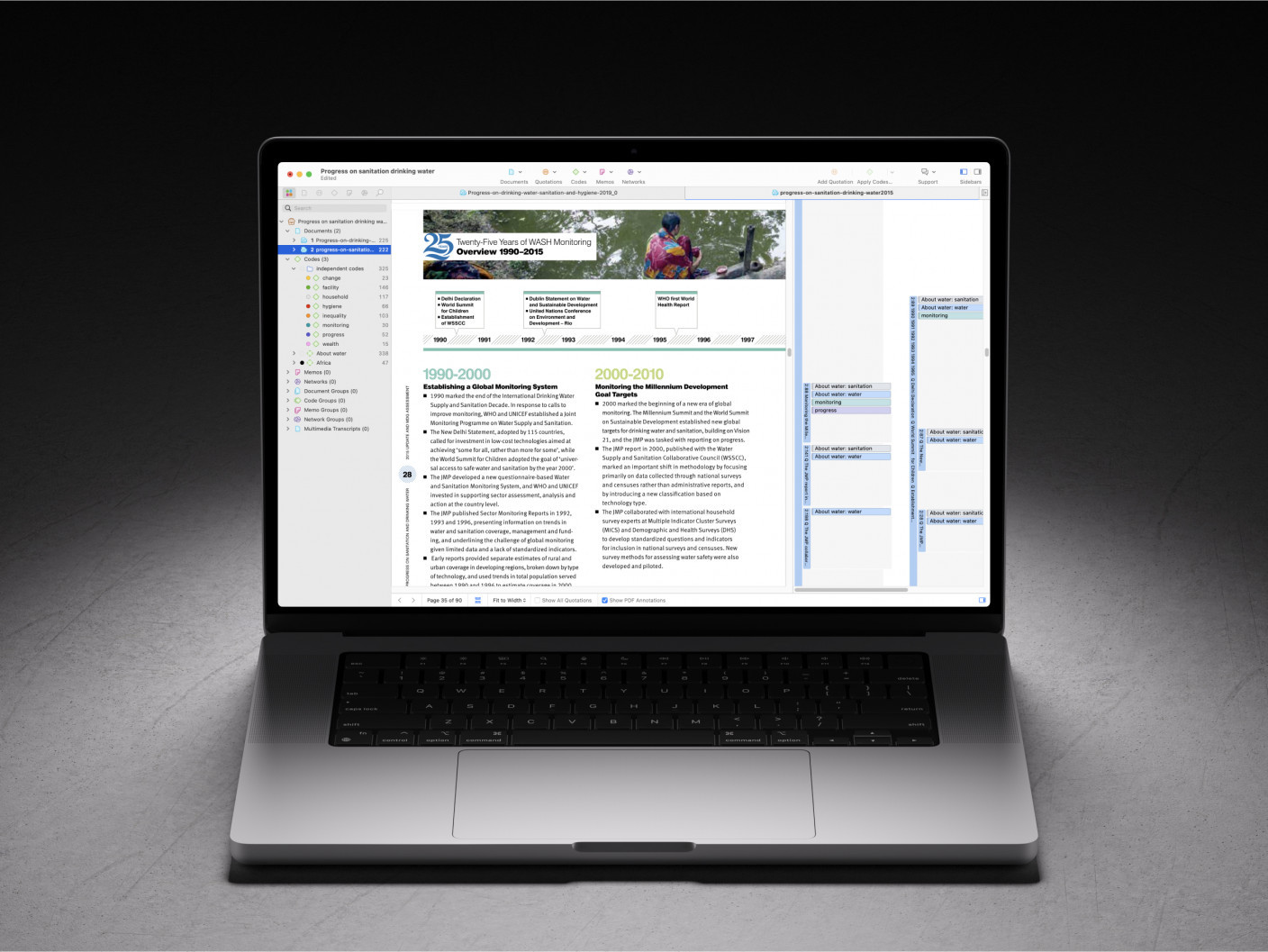Machen Sie den Traum wahr mit Teamwork in ATLAS.ti Web
- Einführung
- Einrichten eines Projekts zur Zusammenarbeit mit anderen in Echtzeit
- Kommunikation ist der Schlüssel
- Abschluss
- Wie zitiere ich "Machen Sie den Traum wahr mit Teamwork in ATLAS.ti Web"
Einleitung
ATLAS.ti Web ist die vollständig cloud-basierte Version der leistungsstarken Software zur qualitativen Datenanalyse. Einer der größten Vorteile von ATLAS.ti Web ist die Möglichkeit, mit anderen in Echtzeit zusammenzuarbeiten. Sie können Ihr Forschungsprojekt erstellen und so viele Personen einladen, wie Sie möchten. Jede Person kann von ihrem eigenen ATLAS.ti-Account aus an dem Projekt arbeiten, und das Projekt wird automatisch gespeichert und auf allen Accounts aktualisiert. ATLAS.ti behält den Überblick darüber, wer was gemacht hat und zeigt den Namen und das Foto jeder Person deutlich an. Mit anderen Worten: Sie müssen sich keine Sorgen mehr machen, dass Sie Beiträge oder Änderungen am Projekt übersehen.
Ein Projekt einrichten, um in Echtzeit mit anderen zusammenzuarbeiten
Sobald Sie ein Projekt in ATLAS.ti Web erstellt haben, können Sie Ihre Teammitglieder einladen, indem Sie auf den Button "Add new project member" klicken. Sie finden diese Option auf der Seite mit den Projekteinstellungen (siehe Abbildung 1) sowie am oberen Rand eines jeden geöffneten Dokuments (siehe Abbildung 2).
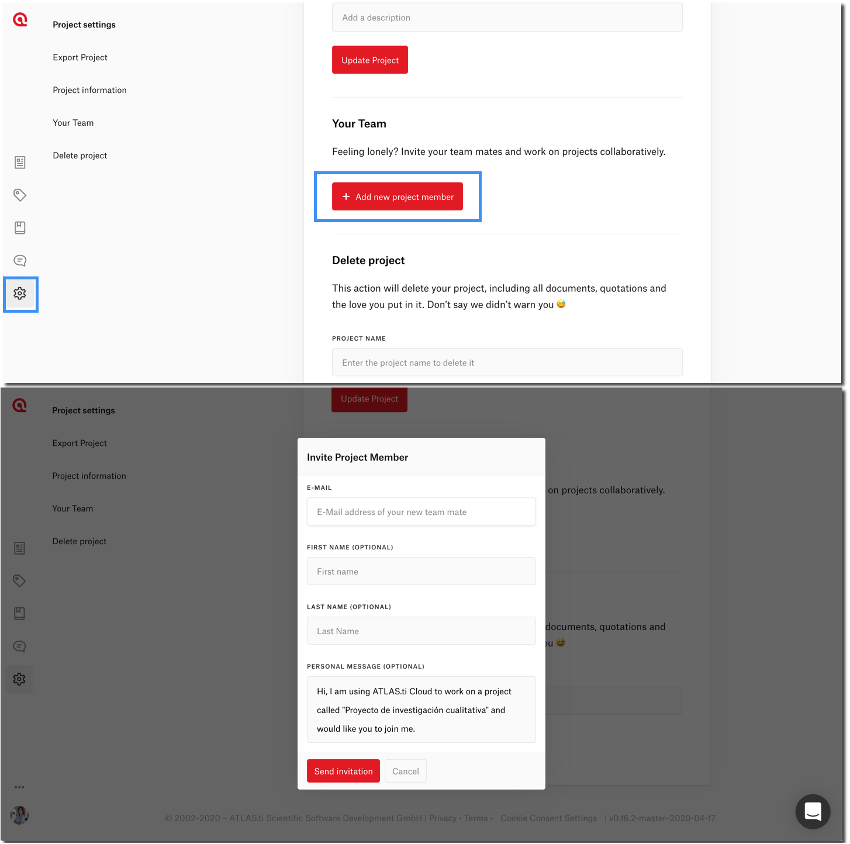

Sobald Sie Einladungen an andere verschickt haben, können Sie den Status der einzelnen Einladungen auf der Projekteinstellungsseite einsehen (siehe Abbildung 3). So können Sie sehen, wer Ihre Einladung angenommen hat, wessen Einladung noch aussteht, und Sie können Einladungen leicht erneut versenden (wenn jemand seine Einladungs-E-Mail nicht finden kann, lohnt es sich, den Spam- bzw. Junk-Posteingang zu überprüfen, nur für den Fall, dass die E-Mail dort landet).
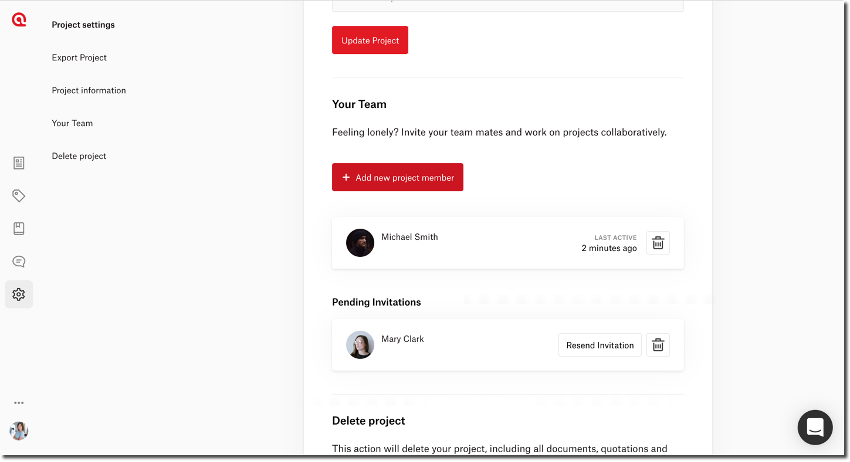
Nachdem eine Einladung zur Zusammenarbeit angenommen wurde, kann die betreffende Person das Projekt von der Startseite ihres ATLAS.ti Web-Accounts aus sehen. Sobald die Person im Projekt ist, kann sie in den Einstellungen des Projekts sehen, wer zu ihrem Team gehört (siehe Abbildung 4).
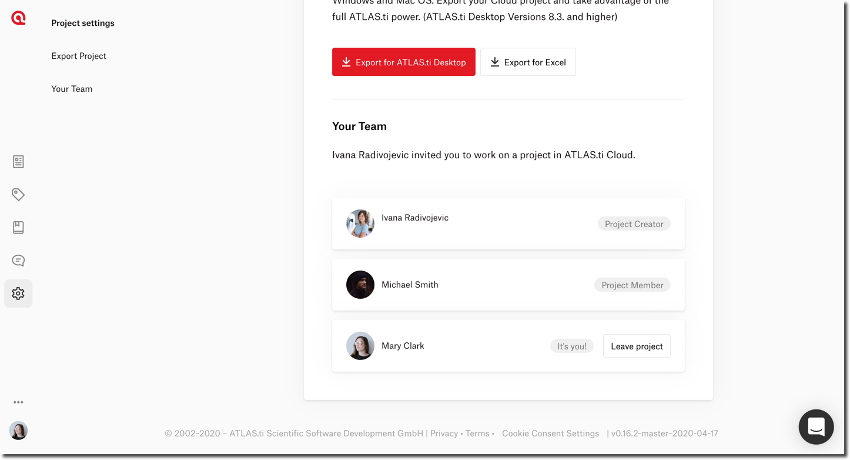
Wenn Sie Ihrem Projekt Mitwirkende hinzufügen, fragen Sie sich vielleicht, ob alle die gleichen Rollen oder Rechte in diesem Projekt haben? Nun, obwohl jedes Teammitglied an der Analyse der Daten arbeiten kann, bleibt die Rolle des Projekterstellers klar abgegrenzt, und nur er kann das Projekt löschen oder weitere Mitarbeiter hinzufügen. Selbst wenn ein Teammitglied das Projekt verlässt, bleibt die von ihm geleistete Arbeit im Projekt erhalten. Tabelle 1 gibt einen Überblick über die Rollen und Rechte bei der Teamarbeit in ATLAS.ti Web.
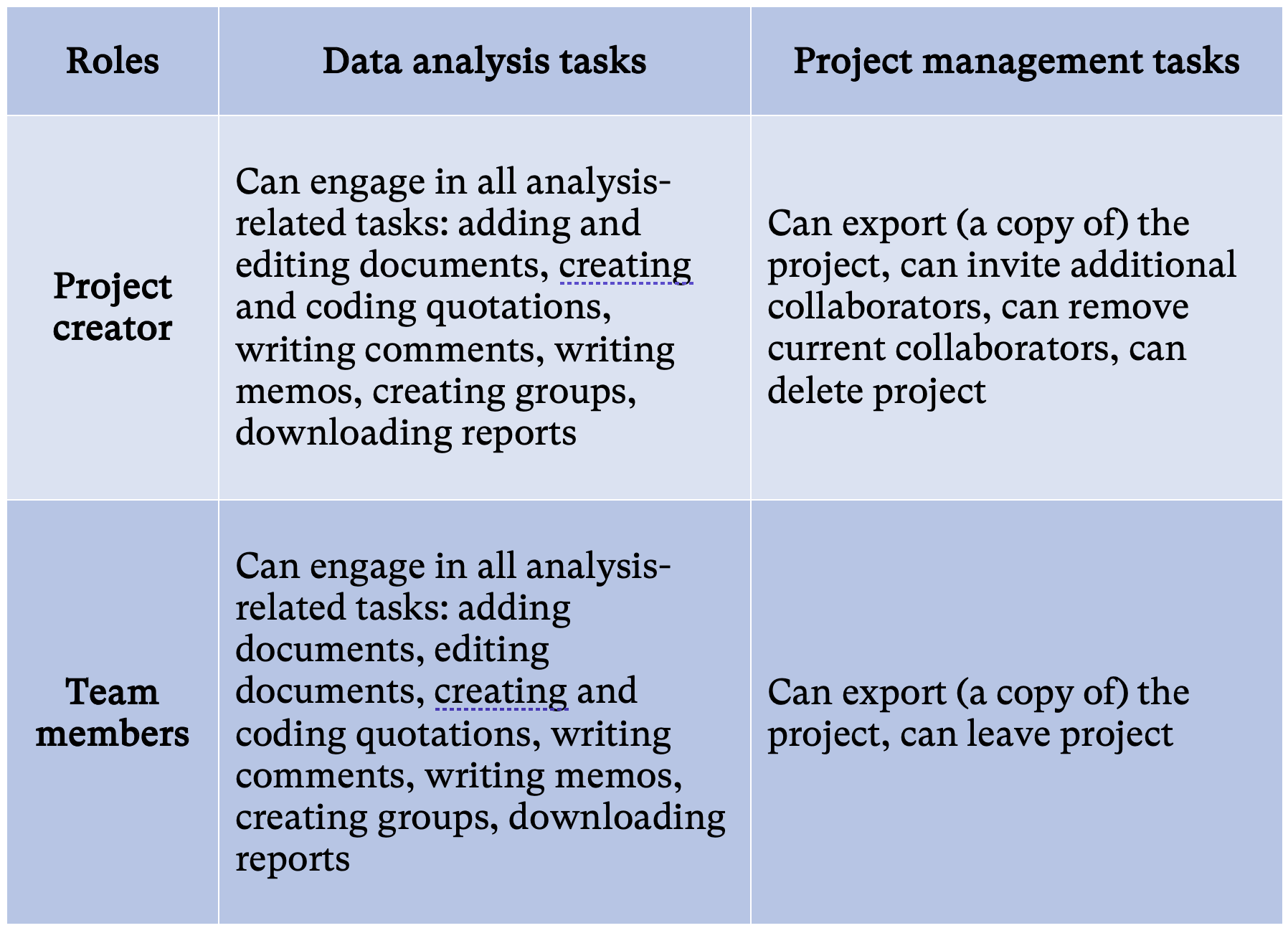
Wie könnten Sie nun ATLAS.ti Web nutzen, um Ihre Zusammenarbeit zu erleichtern?
Kommunikation ist der Schlüssel
Sie können Ihre qualitativen Daten in ATLAS.ti analysieren, indem Sie Textabschnitte markieren und mit Codes versehen. Wenn Sie mehr darüber erfahren möchten, wie man in ATLAS.ti Web Analysen durchführt, besuchen Sie bitte unser Hilfe-Center. ATLAS.ti Web behält den Überblick darüber, wer was gemacht hat - Sie können das Foto jeder Person im Randbereich eines geöffneten Dokuments deutlich sehen, und Sie können sehen, wer jeden Teil des Projekts erstellt hat, indem Sie mit der Maus über ein beliebiges Objekt fahren (siehe Abbildung 5).
Sie können Ihre qualitativen Daten in ATLAS.ti analysieren, indem Sie Textabschnitte markieren und mit Codes versehen. Wenn Sie mehr darüber erfahren möchten, wie man in ATLAS.ti Web Analysen durchführt, können Sie das gerne tun explore our help center. ATLAS.ti Web behält den Überblick darüber, wer was gemacht hat - Sie können das Foto jeder Person deutlich im Randbereich eines geöffneten Dokuments sehen, und Sie können sehen, wer jeden Teil des Projekts erstellt hat, indem Sie mit der Maus über ein beliebiges Objekt fahren (siehe Abbildung 5).

Während es relativ einfach sein mag, herauszufinden, wie man Daten kodiert, kann die Aufrechterhaltung einer klaren Kommunikation mit Ihrem Team eine Herausforderung darstellen. Wie können die Teammitglieder Ideen und Vorschläge austauschen? Wir möchten zwei (vielleicht unterschätzte) Features von ATLAS.ti-Projekten hervorheben: die Kommentarbereiche und Memos.
Jedes einzelne Objekt in ATLAS.ti hat seinen eigenen Kommentarbereich. Mit anderen Worten: Jedes einzelne Zitat, jeder Code, jedes Dokument und jedes Memo hat seinen eigenen Kommentarbereich. Wir können also Kommentare verwenden, um zusätzliche Informationen zu einem bestimmten Objekt zu schreiben. In Tabelle 2 finden Sie einige Vorschläge, welche Art von Informationen in diesen Kommentarbereichen hilfreich sein könnten (aber denken Sie daran, dass die Stärke von ATLAS.ti in seiner Flexibilität liegt, so dass Sie die Kommentarbereiche sicherlich dazu nutzen können, die Art von Informationen zu notieren, die für Sie und die Beantwortung Ihrer Forschungsfragen hilfreich sein werden).

Wenn mehrere Personen an einem Projekt arbeiten, können diese Kommentarbereiche für die Organisation und den Austausch von Ideen unglaublich hilfreich sein. Einerseits ist es wichtig, die Forschungsfrage(n) und das/die Ziel(e) zu beschreiben, um sicherzustellen, dass jeder versteht, was die übergeordneten Ziele des Projekts sind. Darüber hinaus ist die Festlegung einer klaren operationellen Definition für jeden Code unerlässlich, um eine konsistente Kodierung zu gewährleisten; mit anderen Worten, jedes Teammitglied sollte die Bedeutung jedes Codes vollständig verstehen und wissen, wann ein bestimmter Code einem Datenteil zugeordnet werden muss.
Kommentarbereiche erleichtern nicht nur das Verständnis der verschiedenen Teile des Projekts, sondern können auch zum Organisieren und Austauschen von Ideen unter den Teammitgliedern verwendet werden. So können Sie beispielsweise die Namen der Teammitglieder in die Dokumentenkommentare schreiben, um festzuhalten, wer sich auf welches Dokument konzentrieren soll. Sie und Ihr Team können sich auch darauf einigen, immer eine kurze Reflexion zu jedem Zitat zu schreiben (z. B. Warum hat dieses Datensegment Ihre Aufmerksamkeit erregt? Warum haben Sie den/die Code(s) angehängt?), und wenn irgendwelche Zweifel aufkommen, kann die Person ihre Fragen in den Kommentar zum Zitat schreiben, damit das Team später darüber sprechen kann (siehe Abbildung 6 für ein Beispiel). Sie und Ihr Team können sich darauf einigen, Ihre Initialen zu schreiben, damit Sie leicht den Überblick behalten, wer was gesagt hat, wenn mehrere Personen im gleichen Kommentarbereich schreiben.
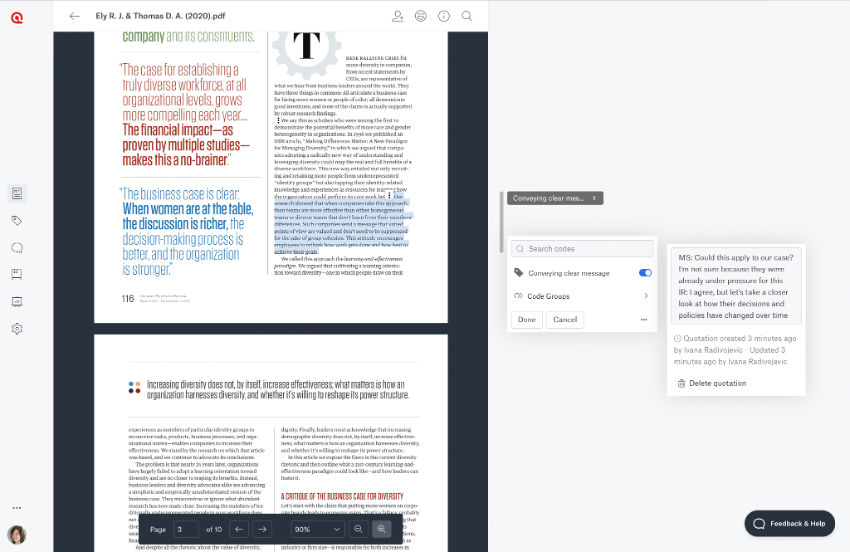
Während sich die Kommentarfelder hervorragend eignen, um die verschiedenen Teile des Projekts zu beschreiben und Ideen zu notieren, bieten Memos einen speziellen Platz für ausführlichere Notizen und Analysen. Sie können z. B. für jedes Hauptforschungsziel oder -konzept ein Memo erstellen, und jede Person kann ihre Ideen, Überlegungen und Analysen hinzufügen. Oder Sie ziehen es vor, dass jedes Teammitglied sein eigenes Memo führt, in dem es zunächst seine analytischen Ideen niederschreibt, und Sie können später die Memos aller Teilnehmer durchlesen und die Erkenntnisse aller zusammenfassen. Sie können so viele Memos erstellen, wie Sie möchten. So können Sie die Vorteile von Memos nutzen, um eine tiefere Analyse der Daten zu ermöglichen und bereits erste Entwürfe des endgültigen Textes zu erstellen.
Wenn es um die Zusammenarbeit mit anderen geht, könnten Sie sogar ein Memo für das "Schwarze Brett" erstellen, an dem die Teammitglieder einander Nachrichten hinterlassen können (siehe Abbildung 7 für ein Beispiel). In einem solchen Memo könnte auch angegeben werden, wer woran arbeitet und welche Fristen für die einzelnen Teile gelten. Kommunikation ist der Schlüssel für koordinierte Teamarbeit, und Memos können den Austausch von Nachrichten und Ideen für Teams besonders einfach machen. Wenn Sie beginnen, viele Memos zu erstellen (z. B. wenn Sie analytische Memos und Teamwork-Memos haben oder jedes Teammitglied seine eigenen Memos erstellt usw.), kann es besonders hilfreich sein, die Memos in Gruppen zu organisieren.

Abschluss
Dank der Live-Zusammenarbeit, bei der die Arbeit aller Beteiligten automatisch gespeichert und aktualisiert wird, ist die gleichzeitige Analyse von qualitativen Daten mit anderen einfacher denn je. Sie können das Foto jeder Person neben ihren Kodierungen sehen und müssen sich keine Gedanken mehr über widersprüchliche Kopien oder fehlende Beiträge anderer machen. Diese Teamwork-Funktionen von ATLAS.ti Web eignen sich sowohl für Forschungsgruppen, die Daten analysieren, als auch für Studenten und Lehrer, die sich mit qualitativer Forschung befassen. Lehrer können Projekte erstellen und ihre Schüler einladen, um das Lernen über qualitative Forschung gemeinschaftlicher und interaktiver zu gestalten. Wir hoffen, dass dieser Artikel Ihnen einige Ideen liefert, wie Sie ATLAS.ti Web auf kreative Weise nutzen können, um Ihr Leben als Forscher, Professor oder Student zu erleichtern.
Wie zitiere ich "Machen Sie den Traum wahr mit Teamwork in ATLAS.ti Web"
APA (7. Auflage)
Kalpokas, N. (2021). Machen Sie den Traum wahr mit Teamwork in ATLAS.ti Web. ATLAS.ti Research Hub. Abgerufen von https://atlasti.com/research-hub/make-the-dream-work-with-teamwork-in-atlas-ti-web
MLA (9. Auflage)
Kalpokas, Neringa. „Machen Sie den Traum wahr mit Teamwork in ATLAS.ti Web.“ ATLAS.ti Research Hub, 2021, https://atlasti.com/research-hub/make-the-dream-work-with-teamwork-in-atlas-ti-web.
Chicago (17. Auflage)
Kalpokas, Neringa. „Machen Sie den Traum wahr mit Teamwork in ATLAS.ti Web.“ ATLAS.ti Research Hub. 2021. https://atlasti.com/research-hub/make-the-dream-work-with-teamwork-in-atlas-ti-web.



